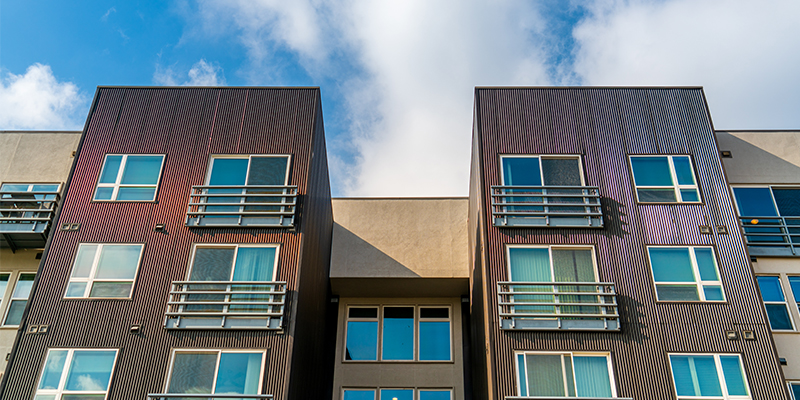By Ed Finkel
The fortunes of the commercial real estate sector should be somewhere between status quo and modestly improved over the next year, with housing, industrial, data center and advanced manufacturing among the most dynamic asset classes, according to a cross-section of developers and investors who sit on NAIOP’s board of directors.
Matt McInnis, partner at Front Street Capital in central North Carolina and a member of NAIOP North Carolina Piedmont Triad, forecasts a mixed picture. “There are a lot of positive dynamics that are unfolding for us, but for every one of those, there’s something that’s going to constrain euphoric growth,” he said. “We see a lot of people finally in a head space where they’re willing to commit to a project. In 2024, there was a lot of looking. That’s started to change.”
That began with the Federal Reserve cutting interest rates and has picked up since the election, McInnis said. “Your political affiliation aside, clarity and certainty are helpful to the business environment,” he said. “In the Southeast U.S., there’s population growth, there’s demand, companies are wanting to domicile here. In North Carolina, there’s a good pro-business climate. We’re not overbuilt.”
Edward Griffin, CEO of Houston-based Griffin Partners Inc., and a member of NAIOP Houston, believes the CRE sector will be in “slightly better shape” than in 2024, with “more transaction volume, more liquidity, and incrementally more liquidity in the debt markets. The cost of debt will not change that much, but the underwriting criteria will probably loosen a little.”
Mike Ferguson, director of business development at Brasfield Gorrie in Raleigh, North Carolina, and a member of NAIOP Raleigh Durham, has an optimistic outlook, in part due to his company’s clients and projects being located primarily in the Southeast, as well as the strength of its asset classes. “It helps to be diversified from a market sector standpoint and location standpoint,” he said. As 2025 begins, “We think we’ve got a good path to … budgeting a lot more projects.”
These three NAIOP board members do not see a major impact from the Fed’s cuts in interest rates. McInnis remains unconvinced that inflation is fully abated and isn’t sure about the impacts of onshoring manufacturing and potential tariffs. “I don’t see interest rates impacting business too tremendously, outside of, at some point, all the debt put on during COVID-19, at rock bottom rates, is going to roll [mature],” he said. “It will be interesting to see what will happen with the backlog of projects that will have to be refinanced.”
Noting that the Fed recently downplayed likely cuts in 2025, Griffin expects slight improvement in the market due to lower interest rates, but nothing that substantial. “I don’t think the 10-year [Treasury] is going to move that much,” he said. “To the extent that the 10-year feeds into cap rates, I don’t think we’re going to see a whole lot of cap rate compression.”
Asset Classes
Housing and industrial will be the most robust asset classes in 2025, McInnis predicts. “People need a place to live,” he said. “On the industrial side, that is something that’s been picked up in capital markets as something attractive in the past five to 10 years. Making and moving widgets on shore has gotten in vogue and will continue to be in vogue.” He added that it’s not always easy to pull together the acreage that you need, especially in tricky topographic terrain like the Piedmont region of North Carolina. “It’s not easy to throw up building after building after building … but I still believe there’s room to run on the industrial side.”
Manufacturing, mission-critical aviation and health care are among the strongest sectors for Brasfield Gorrie, Ferguson said. “Advanced manufacturing is still really hot,” he said. “Onshoring is going to help that. … Mission-critical has skyrocketed as a product for us. That’s going to continue. Then we’re seeing a little bit more mixed-use hotel condo projects get past that budgeting phase compared to 2024.”
Griffin expects to see continued dynamism in industrial and data centers, and although his company isn’t involved in the sector, he’s bullish on multifamily. “Hospitality will likely improve a little bit,” he said. “Office won’t improve very much. We’re probably still a year or more away from meaningful improvements in the overall office market.”
Office: Back-to-Work vs. Adaptive Reuse?
McInnis sees some potential for back-to-work mandates and recalibrated expectations infusing new life into the office sector, but he also expects adaptive reuse conversions to continue. “We see willingness to engage in [new office construction] picking up steam, but we’re not seeing those deals penciling,” he said. “There are a lot of towers that need to be activated or torn down.”
Turning office-only properties into mixed-use with residential and retail brings a “cool factor” that some potential tenants find attractive, McInnis said. “That’s critical if you’re considering delivering new office,” he said. Although for some suburban office tenants, he added, “the fact that there’s parking, and it’s easy to get in and get out, is attractive. There doesn’t have to be a band playing every Thursday night.”
Ferguson sees a flight to quality in the office market, with the higher-end projects leasing up with little problem but Class B and C products struggling. “Those are primed for reinvestment and reinvigoration,” he said, with conversions to residential or possibly to life-science facilities, especially in university-based research areas.
Adaptive reuse projects are challenging outside of high-density coastal markets, Griffin said. “It’s often more economically viable to simply demolish the existing office and build back on the site whatever the new use is going to be,” he said, adding that he expects a gradual pace on return-to-office, with larger companies taking the longest. “The C-suite has made it clear that for most industries, the vast majority, the preference is to have the teams in the office,” he said.
Other Trends and Predictions
What else do these NAIOP board members foresee for 2025? McInnis wonders what banks are going to do with loans written with tight cap rates as they come due. “We have a number of loans that roll [mature] in 2026,” he said. “I fully figured there would be a playbook and a prescriptive way to go through it. It does not feel that way.”
Griffin expects continued bifurcation in the office market, with higher quality products continuing their recovery much more noticeably, while industrial and data center prospects will remain solid, the latter constrained only by the availability of power. He also expects greater opportunities in the Sun Belt, with “the migration we’ve seen from higher tax states to more business-friendly, lower-tax states.”
Brasfield Gorrie’s pre-construction and business development teams have been as busy as they’ve been in a while, which Ferguson sees as “a good indicator of projects getting closer to go. We need capital to get into the market. We need bankers to get going and start loaning. … They’re the first couple of dominos that have to fall.”








